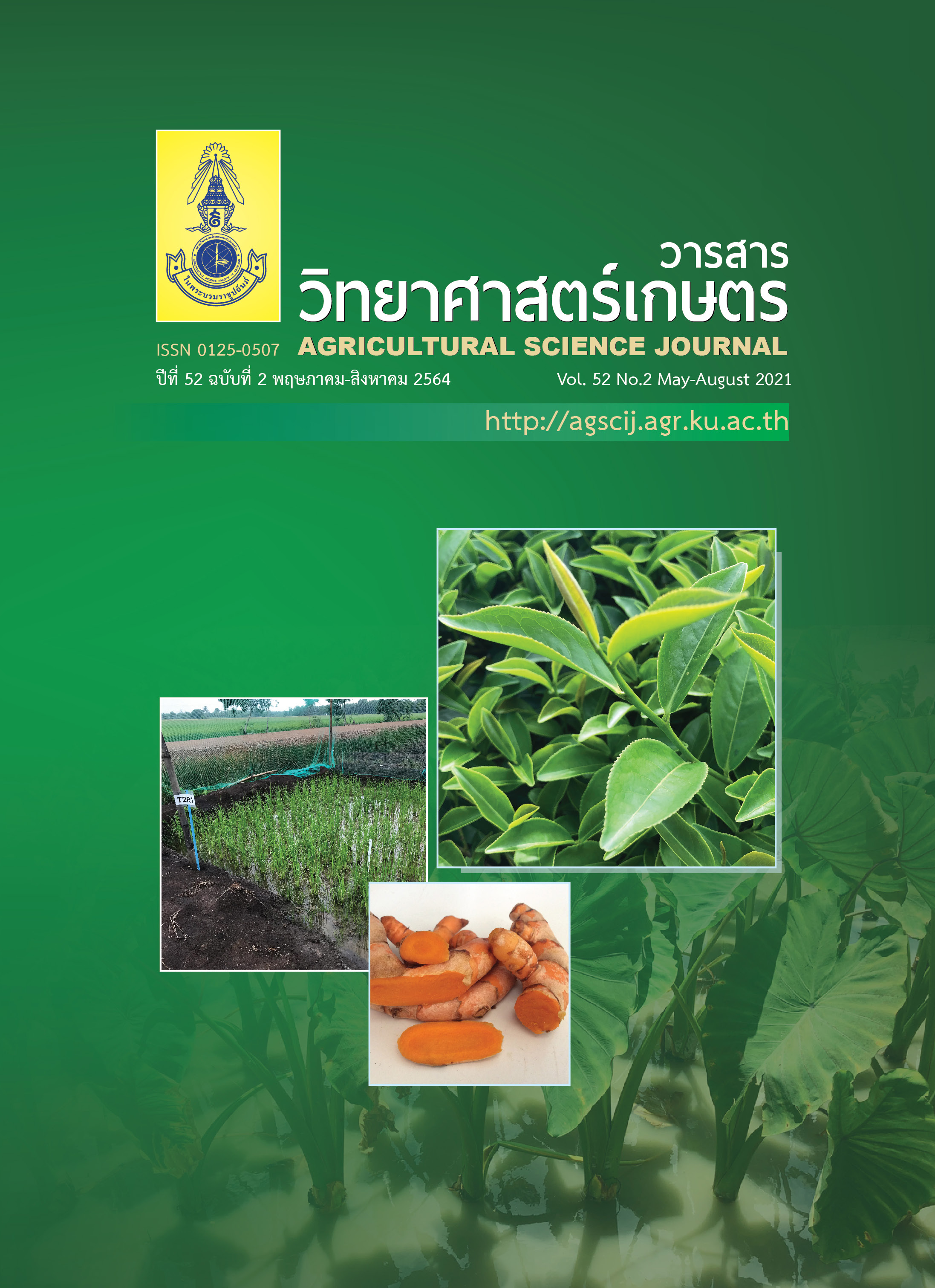อิทธิพลของเถ้าจากโรงไฟฟ้าชีวมวลร่วมกับการใช้ปุ๋ยต่อการผลิตกระถินยักษ์ภายใต้พื้นที่ดินทราย เค็มและกรดสำหรับการใช้ประโยชน์เชิงพลังงานทดแทน
Main Article Content
บทคัดย่อ
การศึกษานี้มีวัตถุประสงค์เพื่อปรับปรุงดินทราย เค็ม และกรดที่อยู่บริเวณใกล้เคียงโรงไฟฟ้าชีวมวล โดยใช้เถ้าจากโรงไฟฟ้าร่วมกับปุ๋ยชนิดต่าง ๆ เพื่อผลิตกระถินยักษ์เป็นเชื้อเพลิงและลดการขาดแคลนเชื้อเพลิงในระยะยาว การทดลองนี้ใช้แผนการทดลองแบบส่มุในบล็อกสมบูรณ์ (Randomized complete block design, RCBD) ทำการทดลอง จำนวน 4 ซ้ำ ปัจจัยที่ศึกษา คือ รูปแบบการให้ปุ๋ยและเถ้าจากโรงไฟฟ้าชีวมวลที่แตกต่างกัน 4 รูปแบบ ประกอบด้วย ใช้ปุ๋ยเคมีสูตร 18–46–0 ผสมกับ 0–0–60 อัตราส่วน 1 : 1 อัตรา 80 กิโลกรัมต่อไร่ (F1) ใช้ปุ๋ยเคมีในอัตราส่วนเดียวกันกับ F1 ที่อัตรา 40 กิโลกรมั ต่อไร่ ร่วมกับเถ้า 1 ตันต่อไร่ และปุ๋ยคอก 500 กิโลกรัมต่อไร่ (F2) ใช้เถ้า 2 ตันต่อไร่ ร่วมกับปุ๋ยคอก 1 ตันต่อไร่ (F3) และไม่ใช้ปุ๋ย (F4) ผลการทดลอง พบว่า แปลงที่ใส่ปุ๋ยแบบ F3 (328.08 เซนติเมตร) และ F1 (276.38 เซนติเมตร) ทำให้กระถินยักษ์มีความสูงเฉลี่ยสูงกว่าแปลง F4 (188.39 เซนติเมตร) อย่างมีนัยสำคัญทางสถิติ (P < 0.05) นอกจากนี้ ยังพบว่าแปลงที่ใส่ปุ๋ยแบบ F3 ให้ผลผลิตน้ำหนักแห้งชีวมวลสูงที่สุด เท่ากับ 1,985.53 กิโลกรัมต่อไร่ เมื่อเปรียบเทียบกับทรีตเมนต์อื่น (P < 0.05) สำหรับองค์ประกอบทางเคมี พบว่า ไม้กระถินยักษ์ทุกทรีตเมนต์มีองค์ประกอบเฉลี่ยของธาตุไนโตรเจน ซัลเฟอร์ และคลอไรด์ต่ำกว่าค่าวิกฤติของเชื้อเพลิงชีวมวล และมีปริมาณเถ้าเฉลี่ย 2.15 กรัมต่อน้ำหนักแห้ง 100 กรัม และมีค่าความร้อนเฉลี่ย 18.20 เมกะจูลต่อกิโลกรัม ซึ่งผ่านค่ามาตรฐานของเชื้อเพลิงชีวมวล จึงสามารถสรุปได้ว่า เถ้าจากโรงไฟฟ้าชีวมวลสามารถนำมาใช้ปรับปรุงสภาพดินทราย เค็ม และกรด โดยผสมกับปุ๋ยคอกในอัตราเถ้า 2 ตันต่อไร่ ร่วมกับปุ๋ยคอก 1 ตันต่อไร่
Article Details
เอกสารอ้างอิง
Basu, M., M. Pande, P.B.S. Bhadoria and S.C. Mahapatra. 2009. Potential fly-ash utilization in agriculture: a global review. Prog. Nat. Sci. 19: 1173–1186.
Bernoux, M., B. Volkoff, M.C.S. Carvalho and C.C. Cerri. 2003. CO2 emissions from liming of agricultural soils in Brazil. Global Biogeochem. Cy. 17(2): 1049.
Bray, R.H. and L. Kurtz. 1945. Determination of total, organic, and available forms of phosphorus in soils. Soil Sci. 59(1): 39–45.
Chotchutima, S., K. Kangvansaichol, S. Tudsri and P. Sripichitt. 2013. Effect of spacing on growth, biomass yield and quality of leucaena (Leucaena leucocephala (Lam.) de Wit.) for renewable energy in Thailand. J. Sustain. Bioenergy Syst. 3: 48–56.
Choudhary, O.P., A.S. Josan, M.S. Bajwa and M.L. Kapur. 2004. Effect of sustained sodic and saline-sodic irrigation and application of gypsum and farmyard manure on yield and quality of sugarcane under semi-arid conditions. Field Crops Res. 87(2–3): 103–116.
Khanna, P.K., R.J. Raison and R.A. Falkiner. 1994. Chemical properties of ash derived from Eucalyptus litter and its effects on forest soils. For. Ecol. Manag. 66: 107–125.
Lewandowski, I. and A. Kicherer. 1997. Combustion quality of biomass: practical relevance and experiments to modify the biomass quality of Miscanthus x giganteus. Eur. J. Agron. 6: 163–177.
Lopez, F., M.M. Garcia, R. Yanez, R. Tapias, M. Fernandez and M. Diaz. 2008. Leucaena species valoration for biomass and paper production in 1 and 2 year harvest. Bioresour. Technol. 99(11): 4846–4853.
Matsi, T. and V.Z. Keramidas. 1999. Fly ash application on two acid soils and its effect on soil salinity, pH, B, P and on ryegrass growth and composition. Environ. Pollut. 104(1): 107–112.
Melero, S., E. Madejon, J.C. Ruiz and J.F. Herencia. 2007. Chemical and biochemical properties of a clay soil under dryland agriculture system as affected by organic fertilization. Eur. J. Agron. 26(3): 327–334.
Ministry of Energy. 2011. Biomass Energy. Energy Policy and Planning Office, Ministry of Energy, Bangkok, Thailand. 90 pp. (in Thai)
Mitchell, J.P., C. Shennan, M.J. Singer, D.W. Peters, R.O. Miller, T. Prichard, S.R. Grattan, J.D. Rhoades, D.M. May and D.S. Munk. 2000. Impacts of gypsum and winter cover crops on soil physical properties and crop productivity when irrigated with saline water. Agric. Water Manag. 45(1): 55–71.
Montes, C.S., D.A. da Silva, R.A. Garcia, G.I.B. de Muniz and J.C. Weber. 2011. Calorific value of Prosopis africana and Balanites aegyptiaca wood: relationships with tree growth, wood density and rainfall gradients in the West African Sahel. Biomass Bioenerg. 35: 346–353.
Montes-Hernandez, G., R. Perez-Lopez, F. Renard, J.M. Nieto and L. Charlet. 2009. Mineral sequestration of CO2 by aqueous carbonation of coal combustion fly-ash. J. Hazard. Mater. 161(2–3): 1347–1354.
Nielsen, H.P., F.J. Frandsen, K. Dam-Johansen and L.L. Baxter. 2000. The implications of chlorine associated corrosion on the operation of biomass-fired boilers. Prog. Energy Combust. Sci. 26(3): 283–298.
Pratt, P.E. 1965. Potassium, pp. 1023–1031. In C.A. Black, ed. Methods of Soil Analysis. Part II. Chemical and Microbiological Properties. Agronomy No. 9. American Society of Agronomy, Madison, Wisconsin, USA.
Raychev, T., S. Popandova, G. Jozefaciuk, M. Hajnos and Z. Sokolowska. 2001. Physicochemical reclamation of saline soils using coal powder. Int. Agrophysics. 15(1): 51–54.
Shahid, S.A. and K. Rahman. 2010. Soil salinity development, classification, assessment, and management in irrigated agriculture, pp. 23–39. In M. Pessarakli, ed. Handbook of Plant and Crop Stress. 3rd edition. CRC Press, FL, USA.
Tudsri, S. 2004. Tropical Forage Crop. Kasetsart University Press, Bangkok, Thailand. 534 pp. (in Thai)
Tudsri, S., K. Kangwansaichol and S. Butnak. 2017. Leucaena: Sustainable Renewable Energy Crop. PS. Print Printing House, Nonthaburi, Thailand. 107 pp. (in Thai)
Tudsri, S., P. Sripichitt, N. Tunmookhaya and S. Boonprong. 2012. Leucaena Management on Low and High Fertile Soil for Energy Application. The 4th Progress Report. PTT Research and Technology Institute, PTT Public Company Limited, Bangkok, Thailand. 62 pp. (in Thai)
Tudsri, S., P. Sripichitt, N. Wongsuwan and K. Nakmanee. 2009. Leucaena Biomass Production for Sustainable Renewable Energy. National Research Council of Thailand, Bangkok, Thailand. 139 pp. (in Thai)
Tudsri, S., Y. Ishii and H. Numaguchi. 2002. Yield and quality tree grass species intercropped with Leucaena leucocephala. J. ISSAAS. 7: 83–90.
Umanu, G. and M.F. Babade. 2013. Biological degradation of kerosene in soil amended with poultry droppings. Int. J. Adv. Biol. Res. 3(2): 254–259.
United States Department of Agriculture. 1998. Soil quality indicators: pH. Available Source: https://www.nrcs.usda.gov/Internet/FSE_DOCUMENTS/nrcs142p2_052208.pdf, June 29, 2021.
Van Paasen, S.V.B, M.K. Cieplik and N.P. Phokawat. 2006. Gasification of Non-woody Biomass. Economic and Technical Perspectives of Chlorine and Sulphur Removal from Product Gas (Non-confidential Version). Energy Research Centre of the Netherlands, Petten, Netherland. 54 pp.
Vityakon, P. 2007. Degradation and restoration of sandy soils under different agricultural land uses in northeast Thailand: a review. Land Degrad. Dev. 18(5): 567–577.
Whalen, J.K., C. Chang, G.W. Clayton and J.P. Carefoot. 2000. Cattle manure amendments can increase the pH of acid soils. Soil Sci. Soc. Am. J. 64(3): 962–966.
Yuwaniyom, A. 2003. Management of Saline Soil. Land Development Department, Bangkok, Thailand. 83 pp. (in Thai)


